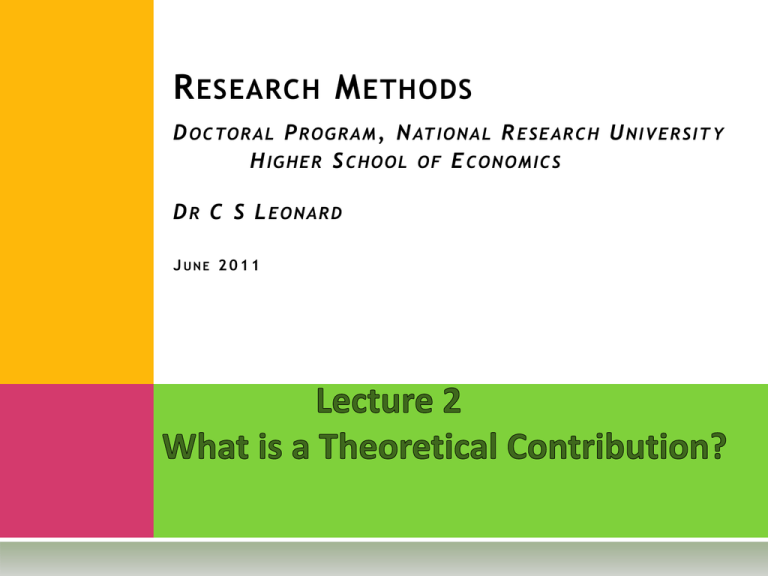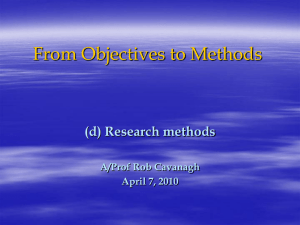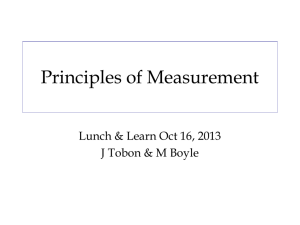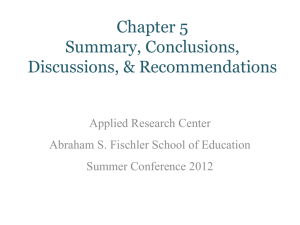Lecture 2 What is a theoretical contribution
advertisement

R ESEARCH M ETHODS D OC TORAL P ROGRAM , N ATIONA L R ES EARC H U NIVERS IT Y H IGHER S C HOOL OF E C ONOM IC S D R C S L EONARD JUNE 2 0 1 1 O UTLINE 2 What is a theoretical contribution? What is a concept? A variable is a concept Validity RESEARCH METHODS External, Internal 8/6/2011 T HEORY RESEARCH METHODS 3 8/6/2011 P RACTICAL 4 GUIDELINES Choose a hypothesis important in literature but for which no systematic study exists—decide in favour or against the hypothesis Choose a theory you suspect is false and investigate if it is, indeed, and what alternate might replace it Design research to illuminate unquestioned assumptions in the literature Argue that a topic of importance has been overlooked Show relation of theory from one literature to separate problem from another RESEARCH METHODS 8/6/2011 R EVISION OF FORMAL THEORIES ? 5 More than just adding a variable Showing how it changes perception of the problem Producing data that are inconsistent with a theory RESEARCH METHODS 8/6/2011 B ORROW FROM OTHER DISCIPLINES ? 6 Shed new light on old theories Investigate qualitative boundaries of a theory, not just quantitative ones Show why a theory will not work in a new application, not just that it does not Focus on multiple elements of a theory, not just one inconsistency RESEARCH METHODS 8/6/2011 E VIDENCE REQUIRED FOR 7 REVISING A THEORY Marshal compelling evidence. This evidence can be logical (e.g., the theory is not internally consistent), empirical (its predictions are inconsistent with the data accumulated from several studies), or epistemological (its assumptions are invalid-given information from another field). RESEARCH METHODS 8/6/2011 P ROVIDE REMEDIES , 8 ALTERNATIVES Is the original actually inferior, Or simply the best we can do? RESEARCH METHODS 8/6/2011 IS 9 IT PUBLISHABLE ? How radically new is the idea? Is it linked to evidence, will it change practice? Why so? Are the underlying logic and supporting evidence compelling? Are the author's assumptions explicit? Are the author's views be-lievable? Well rounded, broad, deep understanding? At professional standards? Who cares? Why now? RESEARCH METHODS 8/6/2011 W HAT THEORY IS NOT: (1) REFERENCES 10 For example: "This pattern is consistent with findings that industrialization produces growth (Marx 1880, Solow 1956) This sentence lists publications that contain conceptual arguments (and some findings). But there is no theory because no logic is presented to explain why industrialization produces growth RESEARCH METHODS 8/6/2011 W HAT THEORY IS NOT: (2) D ATA 11 Introduced to show what patterns are there Not why they are there This approach relies on brute empiricism, where hypotheses are motivated by prior data And not the relevance of theory RESEARCH METHODS 8/6/2011 (3) L ISTS OF VARIABLES 12 AND DEFINITIONS Lists of concepts, similarly, are not theory Need connections between variables explained RESEARCH METHODS 8/6/2011 (4) D IAGRAMS 13 ALONE What is needed is causal inference Time horizon and change over time Diagrams as Stage props, not the performance Logic needs to be spelled out, verbally RESEARCH METHODS 8/6/2011 14 (5) H YPOTHESES : WHAT IS EXPECTED TO OCCUR Well-crafted conceptual argument includes hypotheses They serve as crucial bridges between theory and data Making explicit how the variables and relationships that follow from a logical argument will be operationalized. These are statements about what is expected to occur, not why it is expected to RESEARCH METHODS 8/6/2011 I DEAS 15 AND CONCEPTS A theory generally stems from a small set of research ideas, not a list of testable hypotheses RESEARCH METHODS 8/6/2011 16 Q UALITATIVE /Q UANTITATIVE D ISTINCTIONS Qualitative: Research Questions Quantitative: Set of hypotheses (nul or directional) RESEARCH METHODS 8/6/2011 E VIDENCE FOR YOUR HYPOTHESES / TESTING 17 THEORY When theories are particularly interesting or important, empirical support can be partial: a small set of interviews, a demonstration, experiment, a pilot survey, archival data RESEARCH METHODS 8/6/2011 E VIDENCE FOR YOUR 18 HYPOTHESES May point to why a particular process might be true. Subsequent research indicated May show whether the theoretical statements hold up, or whether they can repeatedly be falsified RESEARCH METHODS 8/6/2011 E XTERNAL VALIDITY RESEARCH METHODS 19 8/6/2011 20 T WO CONCEPTS OF EXTERNAL VALIDITY, AS APPLIED TO THEORY Only one form of validity when the objective of research is to test theory RESEARCH METHODS 8/6/2011 E XTERNAL 21 VALIDITY Such variables only become important in the context of evaluating interventions based on theory. RESEARCH METHODS 8/6/2011 C ONSTRUCT 22 VALIDITY One needs to make a distinction between (1) the construct validity of a concept, as reflected in the convergence (and discrimination) of some particular set of operationalizations of it, and (2) the construct validity of a relation between two concepts, as reflected in the "fit" of that relation within some nomological network. The fit is linked to considerations of external validity. RESEARCH METHODS 8/6/2011 23 S AMPLING IS CRITICAL FOR VALIDITY Four major sampling strategies that might be adopted vis a vis any one aspect or facet of the events under study 1. Sampling homogeneously over the entire study 2. Sampling several subsets, each homogeneous within subset on the facet but differing on it between subsets, so that all the subsets together span the whole range RESEARCH METHODS 8/6/2011 S AMPLING 24 3. Sampling heterogeneously. but in a way that yields an overall distribution of the facet among the cases within the study that reflects (is representative of) the distribution of the facet among cases "in nature” 4. Sampling heterogeneously on the facet but without regard to representativeness. RESEARCH METHODS 8/6/2011 S AMPLING THREATS TO 25 VALIDITY These four strategies offer different opportunities for—and pose different threats to—the exploration of the external validity of any given set of findings with respect to the facet in question. Define external validity: the deliberate and systematic search, on a number of facets, for both the scope and the limits over which that given set of findings does and does not hold. RESEARCH METHODS 8/6/2011 R EPORTING 26 Validity as robustnesss Where are the boundaries? Can findings be replicated? RESEARCH METHODS 8/6/2011 TESTS FOR VALIDITY 27 STAGE 1 STAGE 2 Design: Instrument validity instrument use validity Comparison validity execution validity Hypothesis: Experiment: RESEARCH METHODS Construct validity Operational Nomalogical validity Predictive 8/6/2011 C HECKING VALIDITY 28 Observation: State validity Attribute Pattern validity Process RESEARCH METHODS 8/6/2011 T HEORY RESEARCH METHODS 29 8/6/2011 A THEORY DOES NOT COME FIRST IN 30 RESEARCH Theory: A reasoned and precise speculation about the answer to a research question, including a statement about why the proposed answer is correct Implies several specific descriptive or causal hypotheses RESEARCH METHODS Is consistent with prior evidence about a research question 8/6/2011 C HOOSING 31 A THEORY Possibly, it will be wrong It must be falsifiable-what evidence would convince us? Requires observable implications (many) Observe the principle of parsimony (a judgment about the nature of the world, which is assumed to be simple) These rules assume you have not yet collected the data, which can be used afterwards, to modify your theory RESEARCH METHODS 8/6/2011 A FTER 32 YOUR RESEARCH What to do with a theory Expand it, dropping a condition or variable, to, say, all countries, all regions Make it embrace a larger range of phenomena Do not do the opposite RESEARCH METHODS If the theory does not work for some of your observations, do not squeeze new theory out of a revised and qualified research base Ie, make it less restrictive, but not more restrictive—unless you go back and collect more data and observations beginning with the new hypothesis 8/6/2011 D ATA 33 Ensure reliability Maximize leverage RESEARCH METHODS Explain as much as possible with as little as possible Increase numbers of observable implications with confirmation Improve the theory, improve the data From the beginning, list all the possible implications of your hypotheses— outcomes, responses, interviews, at all levels 8/6/2011 S CEPTICISM 34 Report negative findings Report alternative hypotheses RESEARCH METHODS 8/6/2011 T HEORY C ONCEPT RESEARCH METHODS 35 8/6/2011 C ONCEPT F ORMATION 36 RESEARCH METHODS Rigorous approach to concept formation (Osigweh) Defining meaning boundaries (what the concepts do not include) Minimizing concept misuse, confusion 8/6/2011 C ONCEPT 37 RESEARCH METHODS PRECISION General, yet precise Moving a concept from low to high levels of abstraction Economic oncepts must span several contexts Yet they must provide a precise guide to what is not included 8/6/2011 C ONCEPT I MPRECISION 38 Useless: new contexts too easily fit New topics can be suspect, vulnerable to herding by scholars (CR impact on performance) RESEARCH METHODS 8/6/2011 C ONCEPTS 39 Can be decomposed taxonomically RESEARCH METHODS 8/6/2011 VARIABLES 40 A variable is a special kind of concept. It is a classification into two or more mutually exclusive and totally inclusive categories (e.g., Hage, 1972; Smith, 1975). RESEARCH METHODS 8/6/2011 C ONCEPTS RESEARCH METHODS 41 8/6/2011 42 C ONCEPT TRAVELLING : P OSITIVE CONTRIBUTION Concept travelling, in this sense, means that the concept is precise enough to allow researchers to define it in the same way, and so to test it in a wide range of situations—that is, that the concept is a universal. RESEARCH METHODS 8/6/2011 E XAMPLE 43 Puzzle -- Each use creates essentially the same image anywhere: (a) a maze of activities that cannot be correctly solved outside settings or mental frameworks that prescribe following certain paths or specific combination of paths;(jigsaw?Rubik’s cube)? (b) an exercise of figures, numbers, or behaviours that cannot be engaged in or successfully disengaged in, except through a specific order or steps, procedures, or systems of thought processes; (c) activities that when completed cannot fail to yield exact answers, known solutions, or ultimates that could be exactly predicted beforehand. RESEARCH METHODS 8/6/2011 44 C ONCEPT S TRETCHING ( TO BE AVOIDED ) Multi level governance when refracted through the lens of lived political experiences-- notions of policy transfer and of the complex politics of scale of interventions in time, place and space--needed RESEARCH METHODS 8/6/2011 TOO VAGUE ( STRETCHING ) 45 Decentralization Would be misapplied in different societies Too broad RESEARCH METHODS 8/6/2011 TOO NARROW, AS WELL AS VAGUE : OBSERVATIONAL 46 CONCEPTS Can be moved up or down the abstract ladder Communication puzzle, group, decision, problem, conflict, and participation. RESEARCH METHODS 8/6/2011 HAL High abstract level • Traveling concept domain — Broad coverage, of distinct classes of things High •Stretched concept domain — Broad coverage — Too many classes — Few, but determinate of things lumped together (with little attributes of attention to the distinct classes precision of their — Precise at a many attributes) — Packed or too allembracing universal level ( Connotation (Depth, Intension) I Low Middle 47 E X T E N S I O N , D E N O T A T I B O R N E A D T H ) RESEARCH METHODS 8/6/2011 Connotation (Depth, Intension) 48 IIIIIIIIIIII ( Low Middle MAL Mid abstract level • Generalizable nonuniversal concept domain — Breadth balanced — Medium range concepts — Similarities High E X T E N S I O N , D E N O T A T I B O R N E A D T H ) RESEARCH METHODS 8/6/2011 49 HAL MAL Connotation (Depth, Intension) IIIIIIIIIIII Low Middle High RESEARCH METHODS • Taxonomic domain — Narrow coverage — Many attributes for each class — Distinctive typologies or precise taxonomies E X T E N S I O N , B R E A D T H ) • LAL Configurative situational Low abstract concept level doman — Narrow coverage — Too few attributes — Configurative/ Imprecise taxonomies specific generalities precise at a specific level taxonomies — Precise at a specific level 8/6/2011 M OVING TO THE UPPER 50 LEFT CORNER Move up the ladder by negating Concepts with negation are precise Those without are indeterminant RESEARCH METHODS 8/6/2011 E XAMPLE : STUDIES OF “P ROBLEM ” 51 The concept of problem is studies without its meaning boundaries being distinctively delineated. Generated by concrete, intuitive, ad hoc conceptualizations. Studies of structured problems fall widely apart from a focus on conflict resolution to one on negotiation. RESEARCH METHODS 8/6/2011 T HEORETICAL 52 CONCEPTS Theoretical or universal concepts are defined by their systemic meaning in the sense that each meaning derives from the part that the concept plays in the theory. Open concepts reflect the availability of different operational criteria for application to different contexts. As a result, their meanings are not fully defined by reference to observable things and their characteristics. RESEARCH METHODS 8/6/2011 E XAMPLES 53 Efficacy (Jones, 1986; Osigweh, 1983) Synergy, feedback, adaptation (Osigweh 1985b, pp. 153- 157), Homeostasis and isomorphism RESEARCH METHODS 8/6/2011 E MPIRICAL 54 CONCEPTS Observational Can be moved up or down RESEARCH METHODS 8/6/2011 E XAMPLES 55 communication, puzzle, group, decision, conflict RESEARCH METHODS 8/6/2011 M OVING 56 UP THE LADDER Requires that you keep it clear and not just extend meaning to other kinds of observations RESEARCH METHODS 8/6/2011 A DVICE 57 Define a concept by saying what it is not; Give it precise boundaries Make it clear RESEARCH METHODS 8/6/2011 T HEORETICAL C ONTRIBUTION RESEARCH METHODS 58 8/6/2011 C OMPONENTS 59 Which factors (variables, constructs, concepts) logically should be considered as part of the explanation Two criteria exist for judging the extent to which we have included the "right" factors: RESEARCH METHODS comprehensiveness (i. e., are all relevant factors included?) and parsimony (i.e., should some factors be deleted because they add little additional value to our understanding?). 8/6/2011 R ELATIONSHIPS 60 Operationally this involves using "arrows" to connect the "boxes." Such a step adds order to the conceptualization by explicitly delineating patterns. It typically introduces causality. RESEARCH METHODS 8/6/2011 W HY 61 IMPORTANT ? What justifies the selection of factors and the proposed causal relationships? This rationale constitutes the theory's assumptions It welds the model together. Why should colleagues give credence to this particular representation of the phenomena? The answer lies in the logic underlying the model. The soundness of fundamental views of economics or processes RESEARCH METHODS 8/6/2011 F ROM 62 THE EDITOR : “The mission of a theorydevelopment journal is to challenge and extend existing knowledge, not simply to rewrite it. Therefore, authors should push back the boundaries of our knowledge by providing compelling and logical justifications for altered views.” RESEARCH METHODS 8/6/2011 S ET 63 CONTEXTUAL LIMITS These temporal and contextual factors set the boundaries of generalizability, and as such constitute the range of the theory. Do theoretical effects vary over time, either because other timedependent variables are theoretically important or because the theoretical effect is unstable for some reason. RESEARCH METHODS 8/6/2011 S UMMARY 64 For purposes of publishing: Clarity in main ideas Currency in quality RESEARCH METHODS 8/6/2011 P UBLISHING IN E CONOMICS 65 Papers are assumed to vary along two quality dimensions The former is interpreted as the importance of a paper’s main ideas and the latter as other aspects of quality. Observed trends are thought of as reflecting increases in this RESEARCH METHODS 8/6/2011 T HE END




